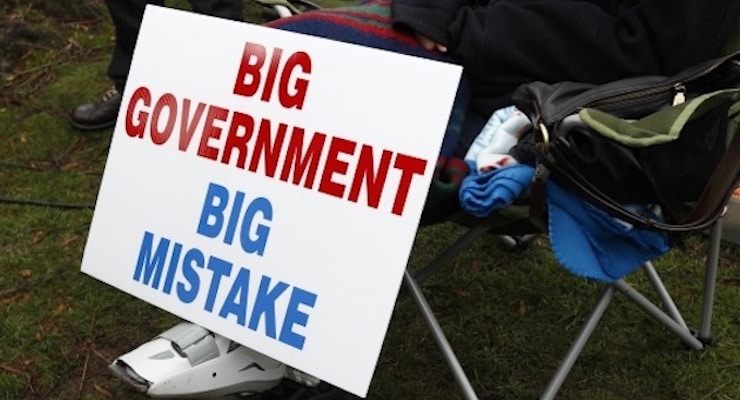

A protestor rests next to their big government big mistake sign. (Photo: Reuters)
The American economy is in the doldrums and has been for most of this century thanks to bad policy under both Barack Obama and George W. Bush. So, what’s needed to boost growth and create jobs? A new video from Learn Liberty, narrated by Professor Don Boudreaux (who also was the narrator for Learn Liberty’s superb video on free trade vs. protectionism), examines how to get more people employed.
[brid video=”43111″ player=”2077″ title=”2016 Presidential Election Job Creation Learn Liberty”]
A very good video. There are three things that grabbed my attention.
First, there’s a very fair compilation of various unemployment/labor force statistics. Viewers can see the good news (a relatively low official unemployment rate) and the bad news (a lowest-in-decades level of labor force participation)
Second, so-called stimulus packages don’t make sense. Yes, some people wind up with more money and jobs when politicians increase spending, but only at the expense of other people who have less money and fewer jobs. Moreover, Don correctly notes that this process of redistribution facilitates cronyism (the focus of another Learn Liberty video) and corruption in Washington, an issue I’ve addressed in one of my videos (below).
[brid video=”8397″ player=”2077″ title=”Mitchell Want Less Corruption Shrink the Size of Government”]
Third, free markets and entrepreneurship are the best routes for more job creation. And that requires less government. Don also correctly condemns occupational licensing rules that make it very difficult for people to get jobs or create jobs in certain fields.
The entire video was very concise, lasting less than four minutes, so it only scratched the surface. For those seeking more information on the topic, I would add the following points.
- Businesses will never create jobs unless they expect that new employees will generate enough revenue to cover not only their wages, but also the cost of taxes, regulations, and mandates.
 This is why policies that sometimes sound nice (higher minimum wages, health insurance mandates, etc) actually are very harmful.
This is why policies that sometimes sound nice (higher minimum wages, health insurance mandates, etc) actually are very harmful. - Redistribution programs make leisure more attractive than labor. This is not only bad for the overall economy because of lower labor force participation. This is why policies that sometime sound nice (unemployment benefits, food stamps, health subsidies, etc) actually are very harmful.
Let’s augment Don’s video by looking at some excerpts from a recent column in the Wall Street Journal by Marie-Joseé Kravis of the Hudson Institute.
In economics, as far back as Joseph Schumpeter, or even Karl Marx, we have known that the flow of business deaths and births affects the dynamism and growth of a country’s economy. Business deaths unlock resources that can be allocated to more productive use and business formation can boost innovation and economic and social mobility. For much of the nation’s history, this process of what Schumpeter called “creative destruction” has spread prosperity throughout the U.S. and the world. Over the past 30 years, however, with the exception of the mid-1980s and the 2002-05 period, this dynamism has been waning. There has been a steady decline in business formation while the rate of business deaths has been more or less constant. Business deaths outnumber births for the first time since measurement of these indicators began.
Why has entrepreneurial dynamism slowed? What’s happened to the creative destruction described in a different Learn Liberty video?
Unsurprisingly, government bears a lot of the blame.
Many studies have also attributed the slow rate of business formation to the regulatory fervor of the past decade. …in a 2010 report for the Office of Advocacy of the U.S. Small Business Administration, researchers at Lafayette University found that the per employee cost of federal regulatory compliance was $10,585 for businesses with 19 or fewer employees.
Wow, that’s a powerful real-world example of how all the feel-good legislation and red tape from Washington creates a giant barrier to job creation.
And it’s worth noting that low-skilled people are the first ones to lose out.
P.S. My favorite Learn Liberty video explains how government subsidies for higher education have resulted in higher costs for students, a lesson that Hillary Clinton obviously hasn’t learned.
P.P.S. Perhaps the most under-appreciated Learn Liberty video explains why the rule of law is critical for a productive society. Though the one on the importance of the price system also needs more attention.
P.P.P.S. And I’m a big fan of the Learn Liberty videos on the Great Depression,central banking, government spending, and the Drug War. And the videos on myths of capitalism, the miracle of modern prosperity, and the legality of Obamacare also should be shared widely.
[mybooktable book=”global-tax-revolution-the-rise-of-tax-competition-and-the-battle-to-defend-it” display=”summary” buybutton_shadowbox=”true”]




